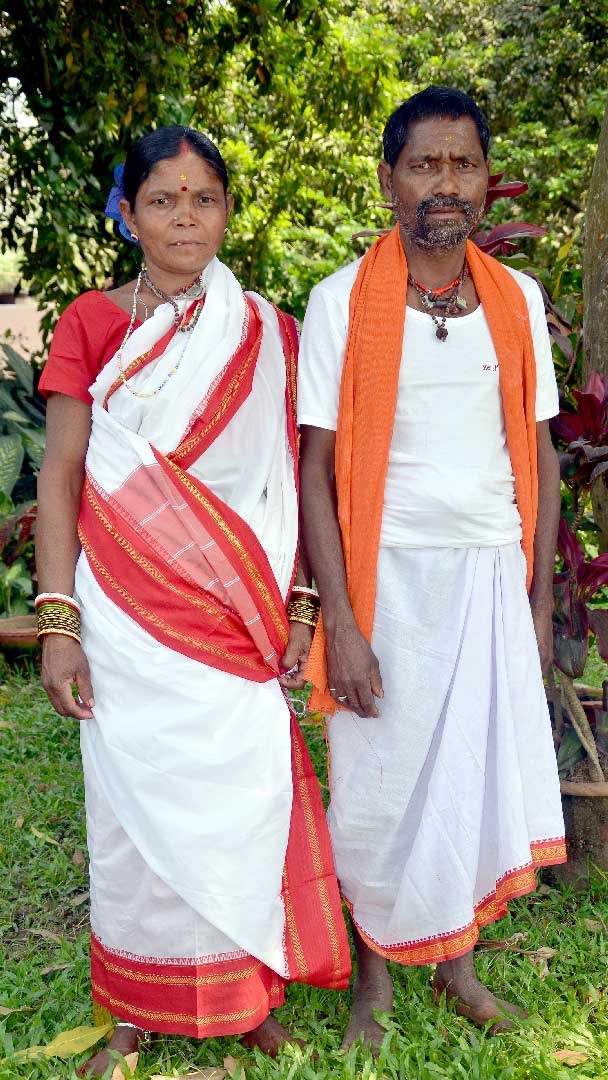TRIBES OF ODISHA
TRIBES OF ODISHA
Juang
Region: Hills of Keonjhar, Pallahara in Anugul and the plains of Dhenkanal
Population*: 8,592
Language: Juang
Map: Click Here
Origin: Residing exclusively in Odisha, the Juang clam Juang Pirh in Keonjhar as their homeland and are divided as Hill (Thaniya) and Plain (Bhagudia) Juang. Originally known as Patuas because of their traditional attire of leaf skirts, the Juang now prefer clothing bought from local markets. The Juang also share a symbiotic relationship with another PTG group, the Paudi Bhuinyas who live in their vicinity. The ancestors of the Bhuinyas and Juang are believed to be brothers according to their common folklore.
Culture and Crafts: Villages are uni-clan in nature with the mandaghar being the traditional youth dormitory in front of which changu dances are held when boys from neighbouring villages come to visit on dancing expeditions.
Occupation: Originally practitioners of shifting cultivation or toila chasa, some of them are now moving to settled agriculture. Hunting is done occasionally, and Juangs of Pallahara are skilled basket weavers also. They are skilled in the making of decorative combs and tobacco cases, and have also taken to domesticating fowl, pigs, goats and cows to supplement their income.
Video:
*Scheduled Tribes Population as per Census 2011 data. PVTGs Population as per Micro Project Survey Data, 2010
Juang
Region: Hills of Keonjhar, Pallahara in Anugul and the plains of Dhenkanal
Population*: 8,592
Language: Juang
Map: Click Here
Origin: Residing exclusively in Odisha, the Juang clam Juang Pirh in Keonjhar as their homeland and are divided as Hill (Thaniya) and Plain (Bhagudia) Juang. Originally known as Patuas because of their traditional attire of leaf skirts, the Juang now prefer clothing bought from local markets. The Juang also share a symbiotic relationship with another PTG group, the Paudi Bhuinyas who live in their vicinity. The ancestors of the Bhuinyas and Juang are believed to be brothers according to their common folklore.
Culture and Crafts: Villages are uni-clan in nature with the mandaghar being the traditional youth dormitory in front of which changu dances are held when boys from neighbouring villages come to visit on dancing expeditions.
Occupation: Originally practitioners of shifting cultivation or toila chasa, some of them are now moving to settled agriculture. Hunting is done occasionally, and Juangs of Pallahara are skilled basket weavers also. They are skilled in the making of decorative combs and tobacco cases, and have also taken to domesticating fowl, pigs, goats and cows to supplement their income.
Video:
*Scheduled Tribes Population as per Census 2011 data. PVTGs Population as per Micro Project Survey Data, 2010
Juang
Region: Hills of Keonjhar, Pallahara in Anugul and the plains of Dhenkanal
Population*: 8,592
Language: Juang
Map: Click Here
Origin: Residing exclusively in Odisha, the Juang clam Juang Pirh in Keonjhar as their homeland and are divided as Hill (Thaniya) and Plain (Bhagudia) Juang. Originally known as Patuas because of their traditional attire of leaf skirts, the Juang now prefer clothing bought from local markets. The Juang also share a symbiotic relationship with another PTG group, the Paudi Bhuinyas who live in their vicinity. The ancestors of the Bhuinyas and Juang are believed to be brothers according to their common folklore.
Culture and Crafts: Villages are uni-clan in nature with the mandaghar being the traditional youth dormitory in front of which changu dances are held when boys from neighbouring villages come to visit on dancing expeditions.
Occupation: Originally practitioners of shifting cultivation or toila chasa, some of them are now moving to settled agriculture. Hunting is done occasionally, and Juangs of Pallahara are skilled basket weavers also. They are skilled in the making of decorative combs and tobacco cases, and have also taken to domesticating fowl, pigs, goats and cows to supplement their income.
Video:
*Scheduled Tribes Population as per Census 2011 data. PVTGs Population as per Micro Project Survey Data, 2010
Juang
Region: Hills of Keonjhar, Pallahara in Anugul and the plains of Dhenkanal
Population*: 8,592
Language: Juang
Map: Click Here
Origin: Residing exclusively in Odisha, the Juang clam Juang Pirh in Keonjhar as their homeland and are divided as Hill (Thaniya) and Plain (Bhagudia) Juang. Originally known as Patuas because of their traditional attire of leaf skirts, the Juang now prefer clothing bought from local markets. The Juang also share a symbiotic relationship with another PTG group, the Paudi Bhuinyas who live in their vicinity. The ancestors of the Bhuinyas and Juang are believed to be brothers according to their common folklore.
Culture and Crafts: Villages are uni-clan in nature with the mandaghar being the traditional youth dormitory in front of which changu dances are held when boys from neighbouring villages come to visit on dancing expeditions.
Occupation: Originally practitioners of shifting cultivation or toila chasa, some of them are now moving to settled agriculture. Hunting is done occasionally, and Juangs of Pallahara are skilled basket weavers also. They are skilled in the making of decorative combs and tobacco cases, and have also taken to domesticating fowl, pigs, goats and cows to supplement their income.
Video:
*Scheduled Tribes Population as per Census 2011 data. PVTGs Population as per Micro Project Survey Data, 2010
PVTG Communities
62 Scheduled Tribes
PVTG Communities
62 Scheduled Tribes
PVTG Communities
62 Scheduled Tribes





